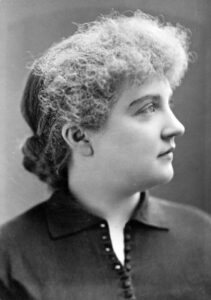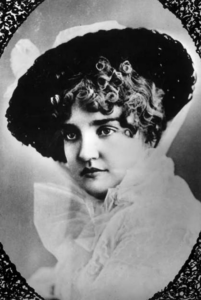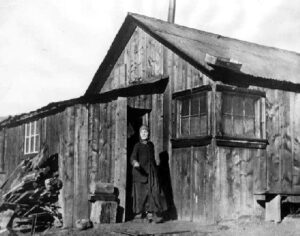With great beauty comes great responsibility. Given Leadville’s uniquely stunning panoramas and high-mountain trails, we…
Women’s History Month: Baby Doe Tabor
Baby Doe Tabor
In the words of Cole Chlouber

Baby Doe Tabor, also known as Elizabeth McCourt Tabor, was an original “rags to riches” story. As a modest Midwesterner, Baby Doe left the Midwest with then husband Harvey Doe, a gentleman she would later divorce sighting drinking, gambling, and an addiction to cat houses (brothels) among the reasons for her split.
The pair had moved to Leadville Colorado, where Baby Doe would meet and marry Colorado businessman and mining mogul, Horace Tabor. The two wed in September of 1882. The marriage was in secret because Horace was actually still wed to his wife of 20 years, Augusta Pierce Tabor, and it was later in 1883 when the pair had found themselves in DC (Horace was serving as Colorado’s interim US senator) that the pair would officially wed. I don’t know if it was Horace’s wealth or new fame from the political spotlight but news raced across the country of Horace’s failed marriage with Augusta. And let me tell you, when a rich man runs off with a woman half his age, well, the western world (and eastern word alike) appeared to be siding with Augusta! This could not have rang more true because when the two then found themselves settled back in Denver with their two young girls, Elizabeth Bonduel Lily Tabor and Rose Mary Echo Silver Dollar Tabor, the couple was scrutinized by Denver’s wealthy elite. And it wasn’t just Denver, headlines nation-wide left the couple living in seclusion, albeit a wealthy seclusion. Baby Doe would escape the seclusion of her daily life by helping with the Woman’s Suffrage Movement, a movement in the late nineteenth century aimed at securing voting rights for women. The movement’s success made Colorado the first state to enact women’s suffrage by popular referendum.
Baby Doe and Horace were also still living like royalty from Horace Tabor’s silver fortune. Sadly, that was the next part of the Tabor empire that was about to fall. And fall it did! In 1893 the Sherman Silver Purchase Act of 1890 was repealed, sending many of these big time mining moguls into unrecoverable debt. Horace was no different. And while this was Horace’s first sight of riches to rags, it wasn’t the first sight of it for Baby Doe and she was committed to do her darndest to make sure Horace would escape it. Unfortunately, he didn’t. Horace instead found himself in bad health, dead broke and penniless. He passed later in 1899.

Before we go on let’s talk about the Sherman Silver Purchase Act, what is it exactly? In short, the Sherman Silver Purchase Act had been passed in response to the growing complaints of farmers’ and miners’ interests. Farmers had immense debts that could not be paid off due to deflation in their industry. This act would allow the farmers to pay their debts with cheaper dollars. At the same time, mining companies had extracted large quantities of silver, so large in that an oversupply was created. This oversupply was so large that it sent silver costs plummeting below a point at which the silver could be profitably extracted from the ground (much like Leadville’s fate with Climax and the molybdenum market in 1983). The farmers and miners came together in hopes that they could get the government to step in and boost the economy, allowing the farmers to pay their debts with these cheaper dollars.
Senator John Sherman was instrumental in getting the conference committee to reach agreement on a final draft of the Act between the senate and house but once an agreement on the final version was reached, Sherman found a distaste with most of the act. Sherman continued his work, creating a package that could pass both the house and senate and still gain presidential approval. And that it did! Under the Act, the federal government purchased millions of ounces of silver with paper currency, becoming the second-largest buyer in the world. the US government was also now required to purchase an additional 4.5 million ounces of silver bullion every month.

This meant that the price of silver was artificially driven up, which drove the more precious metal of gold price out of circulation. Silver became worth less than the government’s legal exchange rate for silver vs. gold. Investors would get around this by buying silver, exchanging it for gold, and then selling the gold in metals markets for more than they had originally paid for the silver. They then took the profits from the transaction and doubled down on more silver, doing this over and over until eventually the Treasury ran out of gold, creating the Panic of 1893. After the Panic of 1893 broke, President Grover Cleveland oversaw the repeal of the act to prevent further depletion of the government’s gold reserves, sending many of these big-time mining moguls into unrecoverable debt.
After Horace’s death, Baby Doe took Elisabeth and Rose Mary back to Leadville. Why? We do not know for sure, but it is rumored that Horace’s dying wish was for Baby Doe to return to Leadville and that his once defunct mine, the Matchless Mine, would again one day stand king among kings with its silver riches. After their return the daughters eventually left, one for the Midwest and the other back to search out a life in Denver similar to her late father and where she would go to work for the local paper. But Baby Doe didn’t. Nope, she continued life, living in a very badly weathered shack on the property of the Matchless Mine. And she would continue on to do so, penniless, and for the next 35 years.

Baby Doe sat in the cabin for the next 35 years with a journal and a return to Catholicism, thinking this might right the wrongs of her prior sinful and lavish lifestyle which she was now laying blame for her current situation. Living off mere bread scraps and water, Baby Doe feverishly recorded her melancholic thoughts of poverty and urgency around it at length in her journals, though most revealed the writings as nothing more than gibberish and crazy ramblings from “the mad woman of Leadville.” Baby Doe was found froze to death in the cabin aside the Matchless Mine 35 years after her return to Leadville.
While most rags to riches stories seem to end happy, obviously this one saw a more Victorian romantic era decline, one more fitting of Leadville history for sure. But what Baby Doe was…she was a woman whose notoriety was well deserved. From her gender-pushing roles among the high society elite social settings, to her living in the limelight as the wife of one of the nation’s early mining and industry moguls, Tabor’s life so colorfully mirrors that of Leadville’s famed boom and bust history. All of these traits, when paired with her feisty, freethinking spirit, place Baby Doe Tabor high among Colorado’s wild west history of unrestrained western women. Thank you Baby Doe, may you Dig Deep, can do attitude wash over us all to challenge that which is before us with the same Grit, guts and determination that you used to unapologetically shape yours.
